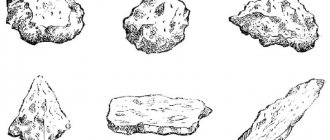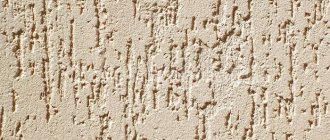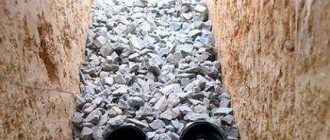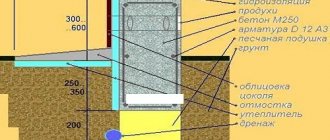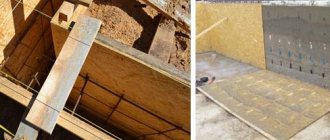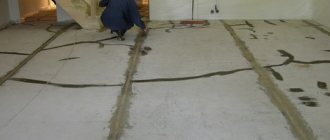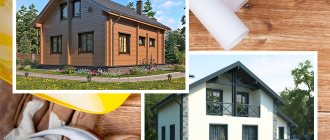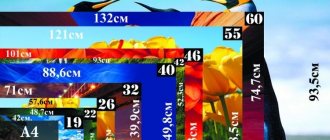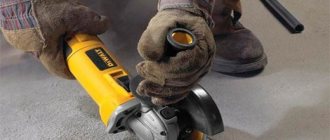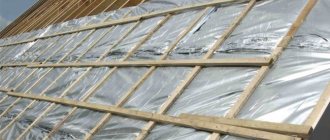A hacksaw for foam concrete is a tool that is used to create additional or shaped blocks necessary for performing certain repairs and construction of structures from the material. Foam concrete is very popular today, especially in low-rise construction, due to such advantages as high heat/sound insulation characteristics, light weight, large size, ideal geometry, and the ability to build an inexpensive house with your own hands easily and without the use of special equipment.
Despite all the advantages, the material is quite fragile, so making an accurate cut and ultimately obtaining a block of the desired size is possible only with the use of tools designed for this. An ordinary hacksaw and equipment suitable for cutting concrete or brick can cause destruction of the blocks and the inability to make an accurate cut along the markings.
In addition, before starting work, it is advisable to take care of additional devices that will facilitate and simplify the cutting process.
Application in construction
It is already known that a foam block hacksaw can be used to cut foam and aerated concrete blocks, as well as other similar building materials. This means that this hacksaw is used on construction sites during the construction of buildings, in construction on summer cottages, wherever foam concrete can be used. You can work with such material using a band saw or reciprocating saw, a circular saw with a disk designed for this, but all these tools are expensive. They are used by organizations and teams with large volumes of construction. For private use, the best option would be a hand saw for aerated concrete. The characteristic features of this tool do not allow it to be used for working with other materials, such as wood or metal. It is more advisable to use it only for its intended purpose.
Description of the tool
Externally, a saw for aerated concrete is no different from ordinary hacksaws for woodworking. It consists of a handle and a cutting blade. The work is done manually using swinging movements. The main feature of the tool is that the teeth have a unique design.
All types of hacksaws of this type are equipped with reinforced teeth coated with Teflon to increase the hardness and rigidity of the saw part. Another advantage of such a hacksaw is the small pobedite soldering on the teeth of the blade, which allows you to improve the quality and efficiency of working with aerated concrete or foam concrete. Components of the tool:
A hacksaw for working with wood can have either a flexible or rigid blade. The hacksaw for aerated concrete with Pobedit tips is equipped with a particularly hard base and increased thickness. Such a blade will not bend or play when cutting aerated concrete. Positive aspects of precision cutting:
- the adhesive mixture is saved due to precise fit;
- time is saved, since there is no need to refine the surface with a plane or float.
Typically a Teflon coating is used. It increases sliding and reduces friction of the web when working with aerated concrete blocks. Anti-corrosion varnish is also used for coating.
A wood saw can also be used to make cuts on aerated concrete. It will just take a lot of time if the blade has small teeth, and if it has large teeth, they will often break. It is in the design of a hacksaw for aerated concrete that all the features of this building material, made from sand, cement, aluminum powder, lime and a number of additives, are taken into account. In addition, all teeth or every other one are reinforced with pobedit tips to enhance the abrasive effect.
Devices for work
Ideal cutting quality can only be guaranteed by the correct choice of tools and related accessories. The markings must be applied as accurately as possible and done correctly. It is imperative to adhere to the basic safety rules adopted on construction sites and relevant for working with this type of tool.
For consistently accurate cutting, the foam block is securely fixed on the working surface, guiding the cutting parts of the tool correctly. To ensure a perpendicular direction to the blade of the tool, it is advisable to make a tulle from a sheet of plywood or boards. A corner for blocks will also come in handy.
In the case when it is necessary to cut a shaped element from a block according to a project, it is most effective to make a template from wood, on which each of the cutting lines is marked with a metal nail. When working with electric saws or on machines, be sure to think through the ventilation system and use personal protective equipment.
Criterias of choice
When purchasing a hacksaw for aerated concrete, you should know its parameters and features, as well as for what volume of work this tool will be used.
You need to pay attention to the thickness and height of the blade, length, what material it is made of, whether the handle is comfortable and who the manufacturer is. The thickness and height of the canvas depends on the size of the foam blocks you will be working with. A thick and tall blade (100 - 120 mm high and 0.5 - 1.5 mm thick) will be needed when working with solid blocks of aerated concrete or foam concrete. The processing in this case will be “rough” , since the cuts will have a rough, rough surface.
If you need more filigree and delicate work (usually when processing small areas of concrete), you need to select a hacksaw with a blade thickness of 0.2 - 0.5 mm and a height of 50 - 70 mm. The fine teeth of such a tool produce smooth and neat cuts.
The length of the blade plays an important role when working with a hacksaw on concrete. It varies from 300 mm to 700 mm. The length must exceed 2 times the thickness of the concrete block, otherwise there will be some inconvenience in work. In the manufacture of hacksaws of this type hardened or stainless steel is usually used , the teeth of the blade are strengthened with pobedit tips, and to extend the service life it is coated with an additional protective layer.
When choosing a saw, you need to pay attention to the handle of the hacksaw. The material from which it is made can be different - wood, plastic, thermoplastic rubber. Usually attached to the canvas with screws. The main thing is that it fits comfortably in your hand for comfortable cutting of aerated concrete blocks.
When choosing a tool manufacturer, pay attention to more well-known companies, and not to Chinese fake models.
Recommendations for performing work
To use the tool more effectively, you need to follow several recommendations. This will help reduce the consumption of effort and time. General recommendations for work:
- Do not work on aerated concrete wet from rain, as dust will stick and impede the movement of the hacksaw.
- Make a miter box (can be made from wood waste). Place it on top of the block, and the canvas will accurately follow the created grooves.
- Correlate the length of the blade and the span to ensure complete removal of concrete chips.
- Mark the blocks using a square.
Choosing the best tool for the job is the main condition for performing high-quality masonry. It is not difficult to choose one, since there is a wide variety of types of hacksaws for aerated concrete from various companies and manufacturers on sale.
How to choose a hacksaw for aerated concrete
This type of building material, such as aerated concrete or foam concrete, appeared relatively recently, but has already gained wide popularity due to its advantages. To work with this material, you need to resort to purchasing special tools, among which special attention is paid to a hacksaw. A hacksaw for aerated concrete allows you to quickly and efficiently cut this material, depending on the emerging needs in the work process.
How to use it correctly
Working with a hacksaw on aerated concrete is not difficult. The tool is attached to the block in the place where the cut needs to be made. You need to cut carefully, without sudden jolts, but quite energetically. In the absence of impacts and jerks, the cut is smooth, without chips or nicks. At first, if you do not have sufficient experience, it is recommended to use a miter box - special grooves placed on the block. The grooves allow you to make straight cuts without deviating. You can only saw a dry gas block.
The correct choice and use of a hacksaw for aerated concrete is the key to high-quality masonry. Do not use improvised means or unsuitable saw blades for sawing blocks, as this will lead to destruction of the gas block.
Application area
Some builders use an ordinary standard wood hacksaw to cut foam concrete, claiming that it does the job no worse than a special saw for this material. However, if an ordinary hacksaw cuts aerated concrete, this does not mean that its use is effective.
Foam concrete has sufficient strength and abrasiveness, so it is not rational to use a wood saw to saw it, as this leads to a rapid dulling of its teeth.
A hacksaw for foam concrete does not have this property, since its teeth are covered with carbide pobedit tips. This allows not only to extend the service life of the tool, but also to facilitate the process of sawing material. The instrument in question is used for the following purposes:
- In order to refine the forms, thereby obtaining foam blocks of the required size.
- For the production of additional prefabricated blocks in an assembly fit, since at least one block in a row always needs to be trimmed.
Where is it used?
Aerated concrete is a lightweight, durable and at the same time fragile material. When laying it, a special cutting tool is required, which is a hacksaw for foam concrete. Many inexperienced craftsmen may advise using a hacksaw to cut gas silicate, but this should not be done. The equipment will quickly be damaged, since it is not intended for such purposes. Only if you don’t have an outdated saw in your arsenal, which has dull teeth and is not suitable for sawing trees. In this case, it can be used to saw foam concrete, but it is better to buy a hand saw for working with aerated concrete.
A distinctive feature of the cutting tool for foam concrete is the presence of carbide pobedit tips on the teeth. These solderings allow you to solve several problems at once:
- Increase tool life. The teeth, due to the strength of the soldering, do not wear out or wear out, so you can cut blocks in large quantities without worrying about damage to the equipment
- Improve and simplify the sawing procedure itself. If you compare the process with sawing wood, cutting concrete by hand is much easier. The only drawback is the generation of dust, so it is better to carry out work in a respirator and safety glasses
- Get rid of the need to buy expensive electric or gas-powered tools to cut gas silicate
The type of device in question is used to implement the following tasks:
- To divide a block into two halves or cut off the excess part
- To finalize the shape of the foam block
- To create an additional prefabricated block, which is necessary when carrying out work on laying building materials
Structurally, the equipment consists of two main parts:
- The working part is a blade that has teeth on one part
- Handle - the handle by which the master holds the device when performing work
A saw for cutting aerated concrete is similar to a hacksaw for wood, but with a slight difference in the shape of the teeth.
How is it different from a hacksaw for wood?
Externally, the tool in question has much in common with a carpenter's hacksaw. The only difference is the following:
- The blade has a length from 500 mm to 700 mm. The increased length of the blade allows the use of equipment for such tasks as sawing foam concrete not only across, but also along
- Increased thickness of steel - sawing durable material requires the appropriate tool. For this purpose, hacksaws are equipped with blades up to 1.5 mm thick
- Teeth - unlike a wood saw, they are arranged in one row, and also have an enlarged shape. In addition, the teeth are tipped with carbide materials.
Not all hacksaws for aerated concrete come with Pobedit tips. Cheap models do not have carbide brazing, and instead the teeth are subjected to heat treatment. These devices have a short resource, so it is important to buy them when performing small volumes of work up to 20-30 cubic meters. blocks. Expensive models of cutting tools have soldering, which are applied both to each link and through one tooth.
Concrete hacksaw and other tools for processing this material
Trying to cut concrete with a regular hacksaw is just a waste of energy, time and breaking the tool, which cannot be said about products made from cellular concrete (gas and foam blocks). In the latter case, you can use a wood saw, but know that it will not last long , as it will quickly begin to grow dull. In this article we will tell you which hacksaw is best suited in this case, and also tell you about other methods of similar processing.
Hacksaw for aerated concrete and a special corner
General information
It should be said right away that the saw for cellular concrete is made of steel, but compared to a similar tool that is familiar to us, its thickness is significantly greater. In this way, the manufacturer eliminated possible deformations that inevitably occur when processing hard materials.
Typically, a hacksaw for aerated concrete is used when it is necessary to obtain blocks of non-standard sizes; they are called additional blocks.
Tip: with its help, as well as a special corner, which is often supplied in a kit, you can cut products into geometrically correct parts with your own hands.
How to choose a tool
Below we will look at the differences between hacksaw models for working with aerated concrete:
- length of the canvas;
- the thickness of the steel, which directly affects the quality of the cut;
- soldered on the teeth, it can be on each or every other one.
Pictured is a special YTONG hand saw
There are two main types of hacksaws on the market – electric and manual.
It remains to be decided which one is best suited in each case.
- Many experts consider hand tools to be the most versatile. It can be used under any conditions, even if there is no power source nearby.
- An electric tool in this case is more complex, although it is more functional. One “but” - there must be a possibility of connecting to the electrical network nearby.
In terms of weight, a manual hacksaw is significantly less than an electric one, and its price is much lower. The approximate difference is 10 times, which very often affects the consumer’s choice.
Bison - Russian hacksaw for aerated concrete
Manufacturers
There is no way around it when choosing a tool and its manufacturers. Some will be discussed below.
| YTONG | It is considered one of the most popular manufacturing companies of such instruments. Hand hacksaws have the following significant advantages: · ease of use; · the blade has a high degree of wear resistance; Convenient handle position. |
| Anchor | 1. Usually the retail price of the tool is two times lower than the previous model.2. The handle is made of two-component material.3. The 670 mm long stainless steel blade has durable teeth, sharpened using special technology. The company is known for the reliability and durability of its products, which is confirmed by numerous studies and positive consumer reviews. |
| Delta | The manufacturer occupies a budget niche among the described tools, the cost of which is half the previous one. The products are made of high-strength steel, and the teeth are made of carbide material. In addition to aerated concrete blocks, they can cut expanded clay and foam concrete. |
| Black & Decker | On our market, a German manufacturer offers an electric hacksaw for aerated concrete, which looks like an ordinary chain saw. Two blades are used in the cutting process. A second set is included as standard. The disadvantage of the equipment is that the steel parts wear out relatively quickly. The main advantage of the design is safety and ease of use. The cost of the product is high. |
| Bison | The most popular manufacturer on the Russian market.1. Each tooth has a carbide brazing, which makes it possible to simplify the process of sawing an aerated concrete block.2. Thanks to the long blade, it is possible to saw the block lengthwise and crosswise. 3. Rubberized two-piece handle makes it easy to use. The cost of the product is about $10. |
Below we will talk about other methods and tools that are used for cutting concrete products.
Hacksaw for foam concrete with carbide teeth
Saws for concrete processing
During renovation or construction, it is often necessary to saw concrete blocks. This is due to their standard sizes, which are not always suitable for consumers. It’s one thing when you need to process lightweight cellular concrete, another thing when you need to saw heavy concrete. The solution to this problem is below in the article.
Electric chain saw for concrete
Manufacturers offer builders modern equipment, which is dominated by saws and machines. The first ones make the process as easy as possible and have several options.
Diamond sputtering
In this case, diamond coating is applied to the discs, blades and chains, since this material is very durable. Of course, no one will spray a real diamond, the cost of which is very high; they use its artificial analogue - cubic zirconia. Its technical characteristics are very close to it, allowing it to be used to its fullest.
Advantages of the technology:
- The openings resulting from cutting concrete do not require further processing.
- It can be used in residential premises because there are practically no shock impacts, sound insulation is not required, since the operation of the saw is almost silent and does not affect human hearing, unlike a rotary hammer.
- The cut can reach a depth of up to 1 m on both sides.
- The speed of work is very high, which makes it possible to save time.
- wall cutters;
- seam cutters;
- rope machines.
Types of equipment
It is divided into manual and special.
The latter includes:
They have high performance, efficiency and power.
Work as a seam cutter
Using hand tools you can also create wall openings, however, of small thickness.
It is divided into:
- electric - reciprocating saws (reminiscent of a jigsaw) and chain saws. Cutting is carried out in a reciprocating motion. The power supply is a stationary power supply or a battery, which makes the device autonomous, but the operating time is short. The cost of the equipment is small, starting from $65;
- hydraulic – circular and chain saws. The equipment is highly powerful;
Petrol wall saw
- gasoline - the main advantage of the equipment is its autonomy. The biggest drawback is that the instructions do not allow work to be done in the building. Depending on the model, the devices may be equipped with chains and disks.
Advice: due to their versatility, gasoline tools are used by services during rescue operations.
Conclusion
Processing blocks of various types of concrete is a fairly common operation during construction or repair work. In this case, special tools are required that have increased strength and can withstand the abrasive characteristics of the material.
They use manual and special equipment, which can be stationary or autonomous. The video in this article will help you find additional information on this topic.
rusbetonplus.ru
About the types of hacksaws for cutting foam concrete
Before choosing a hacksaw for aerated concrete, you need to find out what types there are. Devices differ according to the following criteria:
- Drive type - manual, electric and petrol. What type of hacksaws are for aerated concrete is outwardly clear, but electric and gasoline ones are electric and chainsaws (as well as circular saws and grinders), on which, before carrying out work, you need to install a saw chain with pobeditovy tips or disks
- By type of blade - these are reciprocating blades for hand tools, as well as belt and disk blades for automatic units
If you have a chainsaw or electric saw on your farm, then to work with aerated concrete you only need to buy a special chain with pobedit brazed teeth. However, the cost of such a chain is 2-3 times more than the price of a wood chain, so you can judge for yourself the rationality of such a purchase. If there is a need to purchase a chainsaw with a Pobedit solder for cutting concrete, you can do this in an online store that sells construction equipment.
Hand hacksaws are available in different types, and they differ in the following indicators:
- Blade length - hand tools are produced with blade sizes from 50 to 70 cm. It is better to buy equipment with a long blade, which will allow you to make not only transverse, but also longitudinal cuts of materials
- The thickness of the blade - the thicker the better, but the tool itself is also more expensive. Thick blades do not bend or deform during the sawing process, so the cut is smooth, straight and without distortions. To obtain an even cut, it is recommended to use a corner template or square
- Blade material - alloyed and stainless steels are used for this. These steels are so strong that the tool can be used to cut shell rock.
- The presence of soldering on the teeth - if you want the equipment to serve for a long time, then the presence of soldering on the teeth is mandatory. Not only pobedite (cobalt and tungsten), but also rapid, monocarbide and others are used as hard-alloy materials. There is no need to use silver plating
According to these indicators, the hand tools under consideration differ from each other. If you plan to do the work yourself, then it is better to choose a hand saw for foam concrete that is not cheap, otherwise physical fatigue will quickly occur.
Concrete hacksaw and other tools for processing this
Trying to cut concrete with a simple hacksaw is just a waste of energy, time and breaking the tool, which cannot be said about products made from cellular concrete (gas and foam blocks). In the latter case, it is possible to use a saw on wood, but be aware that for a long time it will not work. not enough, as it will quickly begin to grow dull. In this article we will tell you which hacksaw is best suited in this case, and we will tell you about other methods of similar processing.
Non-specialized information
It’s easy to say that the cellular concrete drinker is made of steel, but when compared with a similar tool that is familiar to us, its thickness is much greater. In this way, the manufacturer eliminated possible deformations that inevitably occur when processing hard materials.
In most cases, a hacksaw for aerated concrete is used when it is necessary to take blocks of non-standard sizes, they are called additional ones.
Tip: with its help, and a special corner, which is often included in the kit, you can cut the products into geometrically correct parts with your own hands.
How to choose a tool
Below we will look at the differences between hacksaw models for working with aerated concrete:
- length of the canvas;
- the thickness of the steel, which directly determines the level of cut quality;
- soldering on the teeth, it is possible on each or every other.
There are two main types of hacksaws on the market – electric and manual.
It remains to decide which one is best suited in each case.
- Many experts consider hand tools to be the most versatile. It can be used under any conditions, even if there is no power source nearby.
- An electric tool in this case is more complex, despite the fact that it is more functional. There is one “but” - there must be a possibility of connecting to the electrical network nearby.
In terms of weight, a manual hacksaw is much smaller than an electric one, and its price is significantly lower. The approximate difference is an order of magnitude, which often affects consumer choice.
Manufacturers
It is forbidden to bypass when choosing a tool and its manufacturers. Some will be discussed below.
| YTONG | It is considered one of the most popular manufacturing companies of similar tools. Hand hacksaws have the following significant advantages: · ease of use; · the blade has a high degree of wear resistance; · ergonomic placement of the handle. |
| Anchor | 1. In most cases, the retail price of the tool is half that of the previous model.2. The handle is made of two-component material.3. The stainless steel blade, 670 mm long, has durable teeth, sharpened using a special technology. The company is known for the reliability and durability of its products, which is confirmed by countless studies and good consumer reviews. |
| Delta | The manufacturer occupies a budget niche among the outlined tools, the price of which is half the previous one. The products are made of high-strength steel, and the teeth are made of carbide material. Apart from aerated concrete blocks, they will be able to cut expanded clay and foam concrete. |
| Black & Decker | On our market, a German manufacturer offers an electric hacksaw for aerated concrete, which resembles a simple chain saw from the outside. During cutting, two blades are used. A second set is included as standard. The disadvantage of the equipment is that the steel parts wear out relatively quickly. The main advantage of the design is safety and ease of use. The price of the product is high. |
| Bison | The most popular manufacturer on the Russian market.1. Each tooth has a carbide tipped, which simplifies the process of sawing an aerated concrete block.2. Thanks to the long blade, it is possible to saw the block lengthwise and crosswise. 3. Rubberized two-component handle makes it easy to use. The price of the product is about $10. |
Below we will talk about other methods and tools that are used for cutting cement products.
Saws for concrete processing
During repairs or construction, it is often necessary to saw cement blocks. This is due to their standard sizes, which are not always suitable for consumers. It is one thing when it is necessary to process light cellular concrete, and another thing to saw heavy concrete. The solution to this problem is below in the article.
Manufacturers offer builders modern equipment, which is dominated by saws and machines. The first ones allow you to reduce the process as much as possible and have a couple of options.
Diamond sputtering
Along with this, diamond coating is applied to the discs, blades and chains, since this material is very durable. It goes without saying that no one will spray a real diamond, the price of which is very enormous; they use its unnatural analogue - cubic zirconia. Its characteristics are very close to it, allowing it to be used completely.
Advantages of the technology:
- The openings resulting from cutting concrete do not require further processing.
- It can be used in residential premises, due to the fact that there are virtually no shock effects, no sound insulation is needed, since the operation of the saw is almost silent and does not affect human hearing, unlike a rotary hammer.
- The cut can be about a depth of up to 1 m on both sides.
- The work speed is quite high, which saves time.
Types of equipment
It is divided into manual and special.
The latter includes:
- wall cutters;
- seam cutters;
- cable cars.
They have high performance, efficiency and power.
With hand tools, it is also possible to create wall openings, but of small thickness.
It is divided into:
- electric - reciprocating saws (reminiscent of a jigsaw) and chain saws. Cutting is carried out in a reciprocating motion. The power supply is a stationary electrical network or a battery, which makes the device autonomous, but the operating time is also short. The price of the equipment is small, starting from $65;
- hydraulic – circular and chain saws. The equipment is highly powerful;
- gasoline – the main advantage of the equipment is its autonomy. The most serious drawback is that the instructions do not allow the creation of works in the building. Depending on the model, the devices can be equipped with chains and disks.
Advice: due to their versatility, gasoline tools are used during rescue operations.
Conclusion
Processing blocks of different types of concrete is a fairly common operation during construction or repair work. In this case, special tools are required that have increased strength and can withstand the abrasive properties of the material.
They use manual and special equipment, which can be stationary or autonomous. The video in this article will help you find additional information on this topic.
blog-oremonte.ru
Choosing the right saw for foam concrete
Only with a competent approach can you buy a hacksaw for good quality aerated concrete and foam concrete. Reviews from owners of such instruments show that you need to pay attention to the following criteria when purchasing:
- Thickness of the tool blade - you can purchase equipment with a blade 0.2 mm thick, but you will have to work hard with it, especially if you work without a square. However, such devices allow you to obtain a finishing cut. Thick blades do not bend during the sawing process and allow you to quickly achieve your goals, but they make the cut rough
- Length - the larger the size, the better, but not always. If you plan to lay foam blocks measuring 200-300 mm, then a hacksaw with a blade 500-600 mm long will be quite sufficient. If you want to choose the right tool length, then the size of the material to be cut needs to be multiplied by two
- Materials from which the blades are made - the performance and efficiency of the device depends on the quality of the steel used in production
- The shape or design of the handle - they are made of plastic, which is covered on top with a rubberized base or silicone. The handle affects the convenience of performing work, which is especially important for large volumes
- Weight plays an important role, since the lighter the equipment, the more difficult it is to saw with it. The craftsman needs to apply additional force to press the device onto the material being cut. Heavy files with pobedite tips require only reciprocating movements from the master
- Manufacturers - the instruments in question are produced by different companies, not only in Russia, but also in Europe, as well as China. It is not relevant to overpay for German quality, since reviews show that models from manufacturers Zubr, Matrix, Sturm, Bacho and others have proven themselves well.
- Price is the main indicator of quality. When buying a cheap hacksaw for aerated concrete, you need to understand that it will not last long. Cheap devices are also called disposable, since they are usually enough for one-time work. A budget saw costs about 600-700 rubles, and a good quality hacksaw with soldered teeth from pobedit will cost several thousand rubles
From the material it is clear what advantages and disadvantages a hand tool for processing foam concrete has. Now we can draw a conclusion about the rationality of using the device in question, as well as the features of its choice.
Hacksaw for aerated concrete: concrete, foam concrete, gas block with Pobedit tips
Aerated concrete hacksaw is a special tool designed for sawing and cutting lightweight cellular concrete, thanks to which you can simplify the task and increase efficiency. Due to the high popularity of aerated concrete in private and industrial construction, the choice and purchase of a hacksaw becomes relevant for everyone who works with the material.
Aerated concrete is a lightweight type of concrete with pores inside. It is light, durable, but fragile. Therefore, a regular hacksaw is not suitable for cutting - the tool will quickly wear out due to the high abrasiveness of aerated concrete, and the block itself may crumble or become cracked. Using a special hacksaw makes it possible to cut blocks into pieces of any size and configuration simply, quickly and efficiently.
Typically, a hacksaw for concrete of this type is used in cases where it is necessary to make additional aerated concrete blocks, adjust the existing material to the required size, create a non-standard shape, etc. Before purchasing a tool for cutting aerated concrete, you need to familiarize yourself with the main characteristics and selection criteria.
Unique equipment for the production of foam blocks and gas blocks
The crisis made us think about creating a simple and reliable device for cutting foam concrete and aerated concrete at an affordable price.
In this regard, we offer high-quality equipment for the production of blocks from cellular concrete (foam concrete, aerated concrete) using cutting technology.
This is a unique cutting installation “Monolith +”, it is very compact and does not require a large area, it can be installed in a garage, a small workshop, or converted into a warehouse for production. The installation is easy to operate, so there is no need to involve specialists for installation and operation.
Designed for cutting foam concrete (aerated concrete) mass 1200 * 800 mm and 600 mm high into 16 blocks with dimensions 200 * 300 * 600 mm. In addition, the design features of the equipment ensure easy replacement of cutting elements and their readjustment to any block sizes. This expands the range of manufactured products.
Installation of equipment for cutting foam concrete and aerated concrete
The equipment for cutting foam concrete and aerated concrete is a single frame structure with dimensions of 2.4 m X 2.1 m and a weight of 450 kg. Therefore, it is enough to transport the installation in a Gazelle car, unload it and connect it to a 380 Volt network and it is ready for work. Power consumption 3 kW. On request we supply 220 volt electric motors. The installation is not only reliable, but also very safe to use.
Installed on the frame:
- screw device for removing the top,
- 2 electric drives driving cutting elements made in the form of strings or band saws,
- a control panel with only two buttons: the “Auger Start” button and the “Frame Start” button,
- winch for raising and lowering the frame,
- trolley on removable rails.
Operation of Monolith + equipment
The equipment works as follows:
A pallet with a foam concrete (aerated concrete) mass is installed on a mobile cart. First, the mass is passed through a screw to remove the top. The cart is then secured. Next, the frame with the moving strings is lowered for simultaneous cutting in the longitudinal and transverse directions. After cutting the foam concrete mass, the frame automatically rises. And the pallet with blocks is removed from the cart and transferred to the warehouse.
Read also: Grounding a three-phase network in a private house
Cutting string
Price of equipment "Monolit +"
Cutting equipment for foam concrete and aerated concrete “Monolith Plus” will require significantly lower costs, and this is very important for those who are just starting their business. Any cost savings at the initial stage means an increase in production profitability and a quick payback on the equipment.
The price of the cutting machine “Monolit +” is 450,000 rubles.
The equipment comes with a 12-month warranty.
| “Monolith +” is indispensable for starting your business. It is universal, reliable, mobile, pays for itself quickly and works for you. |
Order equipment by phone 8 (916) 580-04-34
Aerated concrete blocks are a building material widely used in the construction of residential buildings, industrial and office buildings. Made from cement, lime, aluminum powder, crushed quartz sand, gypsum stone, aerated concrete is a fairly light, porous material.
In production, it is made in blocks, the dimensions are much larger than, for example, brick. Thanks to all these properties, aerated concrete and foam blocks are easy to transport and saw. The construction of walls and partitions takes place in a short time.
When laying walls, for structural strength, it is recommended to lay each subsequent level with offset seams. During any construction, it is difficult to accurately calculate the amount of material required. You can immediately purchase blocks of different sizes. And in this case, it will not be possible to lay out the wall perfectly. You can close the resulting cracks and voids with mortar, but this will affect the strength of the row and the quality of the masonry. Cold bridges form through such places, and all the advantages of the material, such as good thermal insulation, are lost.
It is necessary that each row is laid out in blocks as much as possible. In this case, aerated concrete blocks can simply be cut. You can’t do without cutting when decorating window, door openings, arches, and rosette openings. Various tools are used to cut foam blocks. You can also use a regular wood saw, since the material is cellular and relatively easy to saw.
But when you need to build a house, such a saw will quickly become dull and may break. Foam blocks can be cut with a grinder using diamond blades. The disadvantage of the work will be a large amount of dust, which will instantly clog the ventilation holes of the tool, thereby causing rapid overheating. Builders will need additional protective equipment.
Tools used when working with foam blocks:
- Hand saws
- Reciprocating saw
- Band saw for blocks
- Wall chaser for aerated concrete
- Grater, planer for foam concrete
Read also: How to solder wires
Where is it used?
Quite often, to cut aerated concrete, inexperienced craftsmen take an ordinary hacksaw for wood, which usually ends in damage to the tool and poor quality of the cut. A regular hacksaw is not designed to work specifically with porous aerated concrete, and you need to choose the right tool.
So, sawing with a hand hacksaw will take on average 5 times more time and effort than using a special saw for a gas block. The main distinguishing feature of the tool is the presence of special pobedit (carbide) soldering on all teeth. The pobedite element has increased strength and is used for a reason.
How to saw with different tools
The simplest, cheapest method of sawing blocks is manual. But it is not always possible to obtain an even and precise cut, and the work itself is difficult to perform, taking a lot of time and effort.
What rules should you follow when cutting foam blocks with hand tools:
- Do not put pressure on the saw so that the blade does not deviate to the side and does not cut the cut.
- Before cutting the blocks, it is advisable to make sure that the material is completely dry. Otherwise, wet chips will complicate the work by getting stuck in the cut.
- To get an even cut, the block is marked on three sides and small cuts of 2-3 centimeters are made along them.
- The saw should be held correctly at an angle of 45 degrees. The block must lie completely on the work surface so as not to break off ahead of time.
- It is necessary to cut so that the hacksaw blade completely covers the length of the foam block.
How to use a power tool correctly:
- Before starting work, you need to carefully practice the basic movements with the tool turned off.
- The cut itself is made not by the entire area of the canvas, but by its central part; its size should not exceed 25 centimeters.
- The cuts are made on both sides, going towards each point.
- Chain and circular tools require certain actions: on each side the block is marked with small-depth cuts. If the disk is large, you can try to cut the block in one go.
The use of a gasoline saw is allowed only when there is an urgent need to cut a small number of blocks. And in such a situation, the master must be prepared for a large amount of dust and uneven cuts.
How is it different from a hacksaw for wood?
In appearance, the saw, which can quickly and easily cut foam concrete, is not much different from a hacksaw for wood. There are two main differences.
The main differences between a hacksaw for aerated concrete and a saw for wood:
- The length of the blade is 50-70 centimeters - the element is elongated, making it possible to use the tool for sawing an aerated concrete block not only across, but also lengthwise.
- Greater thickness of steel - concrete (even light) is more durable than wood, therefore the working element is made of a more reliable and durable material. Typically, the thickness of a hacksaw blade for aerated concrete is up to 1.5 millimeters.
- The teeth are arranged in one row and made larger. It is also important that the teeth must be soldered with carbide (usually Pobedit) materials.
True, there are hacksaws for gas blocks that do not require soldering from pobedit. Usually these are budget models, where the teeth are simply heat treated. Such devices demonstrate a small resource, therefore they are suitable for performing a small amount of work (on average, they are enough for a maximum of 20-30 cubic meters of blocks).
All high-quality models of hacksaws for aerated concrete are necessarily made with pobedite soldering, which can be applied to each tooth or every other tooth.
Reciprocating saw
The electric saw makes cuts with flat blades that look similar to the blade of a saber, which is why it got its name. The amplitude of movement of the canvas can be different, it all depends on the model. They vary from 3 to 5 cm. An electric hacksaw easily copes with gas and foam concrete blocks and makes cuts quite quickly. Using the saber model is easy. The operating principle is similar to that of a chain saw.
Models may vary:
- frequency of movements per minute (2.5-3 thousand);
- range of motion (1.9-2 cm);
- Block cutting depth.
Using a reciprocating electric saw, you can quickly and efficiently cut aerated concrete blocks. The speed in many models is controlled by an electronic unit. Cooling occurs through the existing ventilation holes. The vibration level is adjusted and low. The reciprocating saw weighs about 4 kg. Replacing the blades is quite simple.
About the types of hacksaws for cutting foam concrete
Before choosing a tool suitable for performing the tasks, you need to study all existing types and the most common options.
Classification criteria for hacksaws for aerated concrete:
- Drive type - the saw can be manual, gasoline, or electric. Hand saws are similar to hacksaws for wood, electric/chainsaws require a standard design with the need to install disks/saw chain with pobedite soldering before starting work.
- Blade type - hand and reciprocating tools, as well as disk and automatic units.
If the craftsman already has an electric/gasoline saw, to work with a gas block it is enough to purchase a special chain with pobedit soldered on all teeth. But such a chain will cost 2-3 times more than a similar consumable for wood. Therefore, many people prefer to buy a hand saw for not too large-scale work.
Types of hand saws and their characteristics:
- The length of the canvas varies in the range of 50-70 centimeters. The longer the blade, the more possibilities: it will be possible to cut an aerated concrete block across/lengthwise.
- Blade material - usually good hacksaws are made from stainless and alloy steels, which demonstrate high strength and allow you to cut even shell rock.
- The thickness of the canvas - the thicker the better, but the cost also increases similarly. Thick blades do not deform or bend during operation, therefore they give a straighter and more even cut, without distortions. To obtain an even cut, craftsmen also recommend using a square or corner template.
- Soldering on the teeth is a very important point, on which the service life of the tool and, in many respects, the quality of cutting depend. In addition to pobedit, monocarbide, rapid, etc. are also used for soldering.
Band-saw
The tool is a multi-cutter cutting machine. The cutting is carried out with a circular steel strip, on one side having teeth. Band saw performance is high. Thus, using a machine, you can cut foam concrete 20 times faster compared to a manual hacksaw.
Read also: Stove made from gas cylinders drawing
A high-tech alloy of hard metals is used for the guide blade. The machine is indispensable in the construction of large objects. With a band saw you can cut blocks of any width, as the height is adjustable. The big advantage is that this saw does an excellent job with foam and aerated concrete of any type, regardless of whether it is autoclaved or natural.
There are models that cut straight and diagonally. The machine can be equipped with an automated self-tensioning function, which affects the cutting accuracy of concrete blocks. Guide rollers allow you to increase the working life of the band saw, and the gaps in the cutting blade, with the help of which waste is removed, ensure non-stop operation.
The band saw is equipped with eyes and wheels, which makes it possible to transport it. Additional stops in the machine contribute to stability during operation. There is also a dust extraction system, which immediately absorbs all the dust when the machine is operating.
Choosing the right saw for foam concrete
It is not difficult to choose a hacksaw for a gas block that is suitable in terms of characteristics, cost and quality - modern manufacturers offer a fairly wide range, so you can find the ideal option both in Moscow and in the regions.
The main criteria for choosing a hacksaw for aerated concrete:
- The thickness of the canvas starts from 0.2 millimeters, but such a canvas will bend and will not allow it to work normally. By using a square, the problem is partially solved, and the cut is clean. Thick blades allow you to work faster and more efficiently, but they have a rougher cut.
- Length of the canvas - if you plan to lay blocks 20-30 centimeters in size, a canvas up to 60 centimeters long will be sufficient. The correct choice is made as follows: multiply the indicator of the long side of the block by 2 and get the optimal length of the canvas.
- The material used to make the canvas must be of high quality, durable and wear-resistant.
- Design and shape of the handle - the handle is usually made of plastic coated with silicone or rubber. The handle should fit comfortably in the hand and not slip, which is especially important for large cutting volumes.
- The weight of the tool - the less, the more difficult it is to saw, since cutting will require additional effort to press the blade to the material. Heavy hacksaws with pobeditovy tips involve only reciprocating movements and do not require any special effort.
- The size and pitch of the teeth also matter: teeth of 2-2.5 millimeters are suitable for small parts with neat cutting, 3-3.5 millimeters are chosen for medium sizes, 4-6 millimeters are suitable for large blocks.
- Manufacturers – this type of tool is produced by different companies from China, Russia, and Europe. Not only models from well-known European companies (which often cost much more), but also Matrix, Zubr, Bacho, Sturm, etc. have proven themselves well.
- Cost varies within noticeable limits, depending on all of the above characteristics. Budget saws cost 600-700 rubles, high-quality ones with pobedit tips usually start from several thousand.
A hacksaw for aerated concrete is a necessary tool when working with material, the choice of which should be approached responsibly. Only a high-quality saw that is suitable for the operating conditions and assigned tasks will ensure efficient and easy work.
How and which one to choose a hand saw?
Hand saws are used not only for sawing wood materials, but also for other, more durable ones, such as metal and concrete. Of course, tools vary in design and size, depending on what you have to cut. The right choice greatly affects not only the quality of the cut, but also the productivity and durability of the tool. For example, if you cut laminate flooring on concrete with a hacksaw, the edge will be sloppy and further processing will be required. But if, on the contrary, you take a hacksaw for cutting metal or concrete, then the cutting part simply will not withstand such a load.
What materials will you work with?
The table will help you choose a hacksaw that is suitable for your tasks:
| Type of hacksaw | Description |
| Wood saw for straight cuts | It has a wide saw blade, widened at the handle and tapering at the end. Along the edge there are small teeth approximately 3-4 mm high. The length of the working part is usually 30-50 cm, so you can cut down trees in the garden, saw logs and large boards. |
| Jigsaw | This tool is used for sawing thin wood-based materials. It is fundamentally different from a wide hacksaw for wood. The saw blade is a thin metal strip with very fine teeth on the edge (its length is only 12-20 cm). It is fixed at both ends in a D-shaped metal bracket, on one side of which there is a handle. Using such a hacksaw, you can cut out shaped blanks from plywood and chipboard sheets. |
| Bow saw | It looks like a jigsaw, only the bracket is less curved and the saw blade is slightly wider. With this tool you can cut down branches and twigs of trees, as well as perform other work in the garden. Some models have a socket at the base of the handle to attach a rod to allow you to reach high branches. |
| Hacksaw for metal | It consists of a durable U-shaped or C-shaped bracket in which the saw blade is fixed on both sides. The length of the saw blade can range from 15 to 40 cm for different models. Thanks to the sharp, small teeth, you can saw metal sheets, rods, and profiles. Some tools have blade angle adjustment, allowing you to work at an angle of 55, 90 or 360 degrees. |
| Hacksaw for concrete | The tool looks like a hacksaw for wood, only it has larger teeth tipped with carbide material (most often tungsten carbide), which makes the cutting part very durable and allows you to saw hard materials. This saw can be used to work on concrete, foam concrete, aerated concrete or sand concrete. The length of the working part is from 30 to 50 cm. |
| For drywall | This hacksaw has a narrow blade with a serrated edge, and the working part tapers at the end. This allows you to make both straight cuts and shaped ones (for example, when cutting sheets for installing multi-level suspended ceilings of unusual shapes). The length of the blade is usually 15-17 cm, it is soldered into the handle like a regular knife, so it is easy to work with the tool. |
When you decide on the choice of the type of hand saw, based on the purpose of use, you need to understand in more detail how, in addition to design features, the models differ.
All attention to the working part
It happens that the saw gets stuck in the material, and sometimes the saw blade, when sawing across the grain of the wood, seems to “jump” - all this affects both the quality of the cut and the speed of work. To avoid such problems, it is very important to choose a hacksaw that is suitable for your specific tasks. Based on what kind of workpiece you will be processing, what the hardness and structure of the material is, you need to choose a saw blade. This is influenced by several factors:
Material of manufacture
Saw blades are made of steel, most often tool steel, but blades can also be made of alloy or cold-rolled steel. Alloy steel has hardness and high elasticity, which makes the cutting part quite resistant to bending and deformation when processing dense materials. Cold-rolled steel, compared to hot-rolled steel, has increased strength even with a thinner sheet thickness. Some hacksaws have a Teflon coating, which protects the saw blade from corrosion and also reduces friction when sawing by 30%.
Also pay attention to the cutting edge: for working with hard or damp wood, as well as other durable materials, it is better to choose a tool with hardened teeth. They have increased hardness, which is 5-6 times higher than the hardness of teeth with conventional sharpening, therefore they provide fast cutting and will not become dull for many years. But they have one drawback - the impossibility of re-sharpening. If you are cutting soft wood, you can buy a hacksaw with regular teeth that can be sharpened with a file. It is easy to distinguish a hardened tooth from a regular one: hardened metal has a characteristic black color.
Shape and size of teeth
The accuracy and speed of cutting depends on the teeth of the hacksaw. The smaller the tooth, the cleaner the cut will be, but it will take longer to cut. Large teeth allow you to complete work much faster, but it is very difficult to achieve accuracy. Therefore, for sawing logs, boards and large workpieces, it is better to choose a hacksaw with teeth of 6-8 mm, but if you have to deal with small parts, laminate, finishing materials and decorative elements, you should opt for a tool with a tooth size of up to 3 mm. The sharpening of the teeth also affects the accuracy of the cut.
As for the shape of the teeth, the most common type is the dagger tooth. It is an equilateral triangle, sharpened on both sides, so it works when the saw moves in any direction. The chisel-shaped tooth is an asymmetrical triangle, sharpened across the blade, and the inclination of the teeth goes towards the sawing direction, so it is best suited for longitudinal cuts. There are also universal blades that combine the properties of both teeth. Today, hacksaws with 3D-sharpened teeth (triangular sharpening) are in great demand, with the help of which it is easy to make transverse and longitudinal cuts in any direction.
Number of teeth
To determine this parameter, the TPI value is used (from English Tooth Per Inch, which means “teeth per inch”). Since the metric system of measures predominates in our country, to make it easier for you to understand, we remind you that 1 inch = 25.4 mm. For example, if you see that the TPI value is 7, this means that for every 25.4 mm of the saw blade there are 7 teeth. Also, you can see this value: 9-15, which means a variable number of teeth throughout the entire length of the blade. As for recommendations for selection, a hacksaw with a number of teeth of 3-6 is suitable for sawing large workpieces, 7-9 – for medium-sized parts, 9-15 – for sawing thin materials, finishing and decorative elements.
Note! The alignment of the hacksaw teeth plays a big role in the quality of the cut. The setting is done so that the cut in the workpiece is slightly wider than the hacksaw blade - this way it will not get stuck in the material when making longitudinal and transverse cuts. As a rule, for small teeth the setting is done through a tooth to the left/right, and for larger teeth, two adjacent teeth are set through one undone one. In hacksaws for metal, the teeth can be set “along the blade,” that is, the working part has a wave-like shape (this method is applicable if the tooth pitch does not exceed 1 mm).
After assessing the specifics of the work and selecting the tool that best suits its main characteristics, you also need to take care of the practicality of the purchase.
Don't forget to take into account when purchasing a hacksaw
To make working with the tool easy, before buying a hacksaw, pay attention to the handle. It can be wooden or plastic, but the most convenient is a two-component handle with a rubber insert. It provides a secure grip, prevents your hand from slipping and does not rub your palm. Even working for a long time, you will not feel much strain on your hand. If you are buying a hacksaw for carpentry work, then pay attention to models that have a division scale on the blade, like on a ruler. You can markup without interrupting your workflow and using one tool.
If you perform various types of cuts and work with workpieces of different sizes, then a set of replacement blades will not be amiss. The hacksaw can be supplied with accessories of different shapes and with different cutting edges - for making straight and cross cuts, cutting down branches, figure sawing, etc. For example, the MATRIX SPARTA 231255 wood hacksaw comes with 5 replaceable saw blades. Pay attention to the presence of a storage and carrying case or a plastic cap for the saw blade, which covers the sharp edge, eliminating the possibility of getting cut.
So, now you know what parameters to use when choosing a hand saw, and you can easily choose one that is suitable for work in the workshop, in the garden or in construction. Our online store offers more than 500 models for various tasks. Choose and place your order right now!
www.vseinstrumenti.ru
